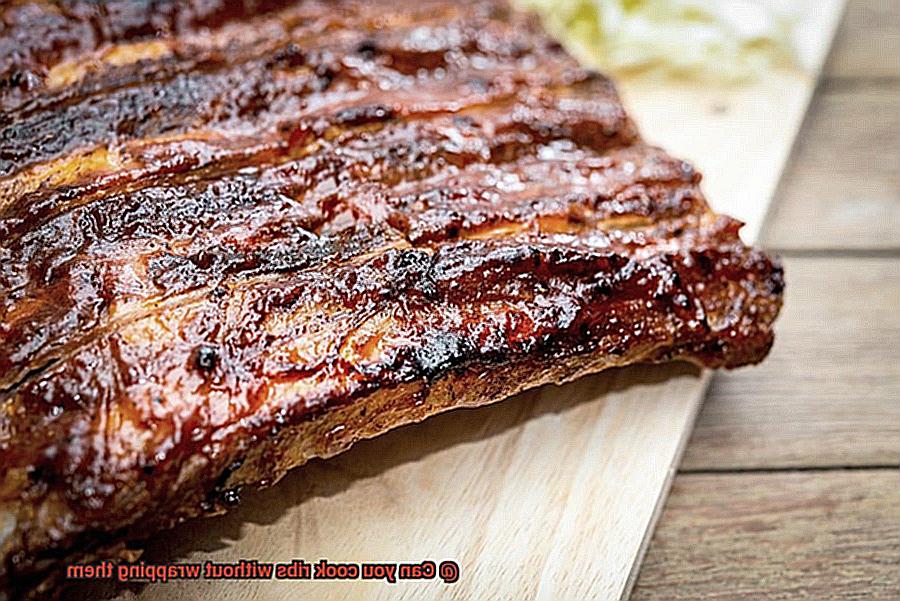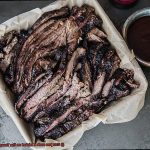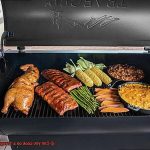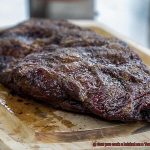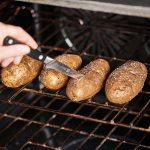Picture this: sinking your teeth into succulent, fall-off-the-bone ribs that are bursting with flavor. It’s enough to make any BBQ enthusiast weak at the knees. But here’s the thing – when it comes to cooking ribs, there’s a debate that has pitmasters divided: to wrap or not to wrap?
Sure, wrapping ribs in foil, aka the “Texas crutch” technique, is a tried-and-true method. But what if I told you there’s another way? A way that doesn’t involve any wrapping at all and still delivers mind-blowing results.
In this blog post, we’re diving deep into the world of cooking unwrapped ribs. We’ll uncover a technique that guarantees smoky perfection, tender texture, and flavors so good they’ll have your friends and family begging for more.
So grab your aprons, fire up those grills, and get ready to take your rib game to a whole new level. No foil required – just pure finger-licking goodness coming right up.
Contents
Dry Rubs and Marinades: Enhancing Flavor
When it comes to cooking ribs, there’s a heated debate among barbecue enthusiasts: to wrap or not to wrap? While wrapping can help retain moisture and tenderness, those who dare to leave their ribs unwrapped are rewarded with a crispy bark and deep smoky flavor. In this blog post, we’ll explore the art of cooking unwrapped ribs and how to enhance their flavor using dry rubs and marinades.
The Power of Dry Rubs:
Dry rubs are a magical blend of spices, herbs, and seasonings that create a flavorful crust on the ribs when cooked. Think of them as a secret handshake between your taste buds and the meat. Salt, pepper, paprika, garlic powder, onion powder, and cayenne pepper come together in harmony to transform ordinary ribs into mouthwatering masterpieces. Generously coat your ribs with the dry rub and let them marinate in the refrigerator for at least 30 minutes to overnight. This allows the flavors to penetrate the meat, creating a symphony of taste.
Marinating for Tenderness:
Marinades are like love potions for your ribs—combining flavor and tenderness in one glorious concoction. They work wonders by breaking down the meat fibers and infusing them with deliciousness. Imagine tangy vinegar or zesty citrus juice mingling with spices and herbs, creating a dance party on your taste buds. Let your unwrapped ribs soak in this elixir for at least 2 hours or overnight in the refrigerator. The longer they marinate, the more intense the flavors become. Before cooking, pat them dry for a perfect sear on the grill.
The Art of Seasoning:
Seasoning is the secret ingredient that elevates unwrapped ribs from good to exceptional. Whether you choose a dry rub or marinade, make sure to apply the seasoning generously and let it work its magic before cooking. This step is the foundation of a flavor explosion that will leave your guests begging for more.
Slow and Low Cooking:
Unwrapped ribs require a slow and low approach to culinary perfection. Picture yourself as a BBQ maestro, carefully tending to your meat masterpiece. Aim for a low temperature of 225-250°F (107-121°C) and let the ribs bask in this gentle heat for 4-6 hours. This slow dance allows the connective tissues in the meat to break down gradually, resulting in tender ribs with a crispy bark. Keep a watchful eye on your creation, spritzing it with a water or apple juice mixture to maintain moisture and prevent any hint of dryness.
Low and Slow Cooking: Controlling Temperature
Are you ready to embark on a culinary journey that will have your taste buds dancing with delight? Then get ready to dive into the world of low and slow cooking, where controlling the temperature is the key to achieving perfectly grilled ribs that will make you the envy of all your friends and family. This technique is not just a method, it’s an art form that requires patience, precision, and a little bit of magic.
To master the art of low and slow cooking, you’ll need the right equipment. Smokers are a popular choice for this style of cooking, as they are specifically designed to maintain a consistent temperature. Equipped with vents that allow you to regulate the airflow, smokers give you complete control over the heat inside the cooking chamber. If you don’t have a smoker, fear not. A charcoal grill can also work wonders. By creating indirect heat, where the coals are on one side and the meat on the other, you can achieve a slow cooking environment. Adjusting the vents or dampers will help maintain a consistent temperature.
Once you have your equipment set up, it’s time to get your digital thermometer ready. This trusty tool will be your best friend throughout the cooking process. Insert the probe into the thickest part of the meat and monitor the internal temperature. Aim for a safe level of around 190°F – 203°F (88°C – 95°C) before removing the ribs from the heat.
Now comes the hardest part – patience. Low and slow cooking takes time. Be prepared to invest several hours into this process. The magic happens when collagen in the meat slowly breaks down, resulting in tender and flavorful ribs that will melt in your mouth. Good things come to those who wait.
Trust the process and resist the temptation to constantly check on your ribs. Each time you open the lid, you release heat and disrupt the cooking process. Have faith in the temperature control methods you have in place and allow the ribs to cook undisturbed. It may be difficult, but the end result will be worth it.
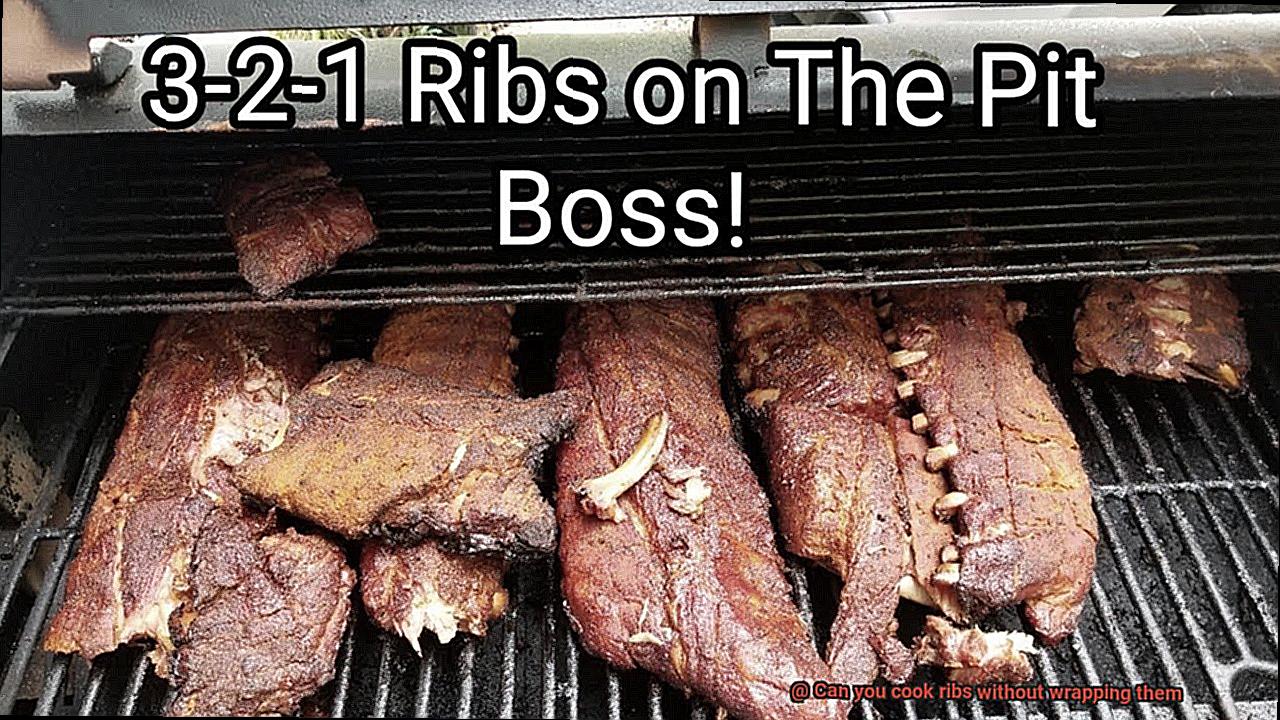
Once your ribs are cooked to perfection, don’t rush to dig in. Let them rest for a few minutes. This allows the juices to redistribute throughout the meat, resulting in even more tender and flavorful ribs that will make your taste buds sing.
Basting: Keeping Moisture and Enhancing Flavor
In this blog post, we’re going to dive into the world of basting and discover how this simple technique can elevate your grilled ribs to new heights. So grab your apron and let’s embark on this flavorful adventure.
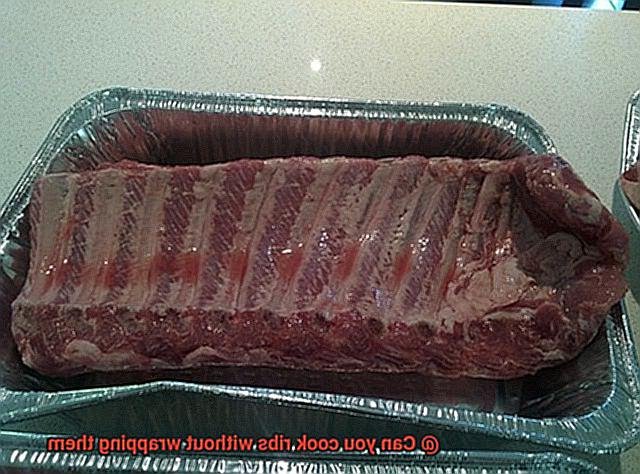
The Importance of Basting:
- Preventing Dryness: Say goodbye to dry and tough ribs. Basting is the key to retaining moisture, ensuring your ribs stay tender and juicy throughout the cooking process.
- Flavor Enhancement: Get ready for an explosion of taste. Basting adds an extra layer of deliciousness by infusing your ribs with the flavors of your chosen liquid – be it a tangy marinade, a sweet barbecue sauce, or even melted butter.
Techniques for Basting Ribs:
- Brush It On: Grab a basting brush and slather the liquid onto your ribs every 15-20 minutes. This technique guarantees optimal moisture retention and flavor infusion, resulting in succulent bites of perfection.
- Spray It Up: Looking for a hands-off approach? Fill a spray bottle with your desired basting liquid and spritz it evenly over the surface of your ribs. This method ensures quick and even distribution, making it ideal for larger quantities or when you crave convenience.
Choosing the Right Basting Liquid:
- Consider Rib Type: Different ribs call for different flavors. For classic barbecue-style pork ribs, reach for a tangy and sweet barbecue sauce that will complement their natural smoky taste. If you’re grilling beef ribs, opt for a savory marinade packed with herbs and spices to enhance their rich flavor profile.
- he Joy of Experimentation: Don’t be afraid to get creative in the kitchen. Explore various marinades, sauces, or even create your own signature basting liquid. Let your taste buds guide you on a flavorful journey of discovery.
Bark Formation: Achieving Crispy Texture
Imagine sinking your teeth into a perfectly grilled rib, only to discover a symphony of flavors exploding in your mouth. The secret behind this mouthwatering experience lies in the crispy, flavorful crust that forms on the exterior of the ribs during cooking – the bark. If you’re wondering how to achieve that coveted crispy bark, look no further. We’ve done the research and compiled some expert tips to help you elevate your grilling game and unlock the full potential of your ribs.
- Start with the Right Rub: To lay the foundation for a mouthwatering bark, it’s crucial to season your ribs with a dry rub that packs a punch. Create a flavor explosion by combining salt, pepper, paprika, brown sugar, garlic powder, and any other spices that tickle your taste buds. The addition of sugar in the rub helps promote caramelization and contributes to the development of that crispy texture we’re after.
- Say No to Wrapping: While wrapping your ribs in foil or butcher paper during cooking can result in tender meat, it prevents the formation of a crispy bark. For those seeking that perfect crunch, cooking your ribs without wrapping is the way to go. Let them bask in the heat and develop their own unique character.
- Sear at High Heat: Before placing your ribs on the grill or smoker, preheat it to a scorching temperature. This initial sear will sear in the juices and kickstart bark formation. It’s like giving your ribs a head start on their path to crispy perfection – a sizzle that sets the stage for greatness.
- Consistent Temperature is Key: Maintaining a consistent temperature throughout the cooking process is crucial for achieving a crispy bark. Become the maestro of your grill symphony by using a thermometer to monitor the heat and adjusting vents or dampers accordingly. This attention to detail will ensure even cooking and a beautiful bark that will make your taste buds dance with joy.
- Choose the Right Wood: Expand your flavor repertoire by smoking your ribs with different wood chips or chunks. Each wood imparts its own unique character, adding another layer of smoky goodness while contributing to bark formation. Woods like hickory, apple, or mesquite are commonly used for smoking ribs. Explore the world of wood flavors and find your preferred flavor profile.
- Baste with Caution: During the cooking process, basting your ribs with a glaze or sauce can add an extra layer of flavor and help enhance bark texture. But be warned – too much liquid can soften the bark and diminish its crispy allure. Exercise restraint and apply a light touch to strike the perfect balance between flavor and crispiness.
- Rest and Rejoice: Once your ribs are cooked to perfection, allow them to rest before serving. This resting period is essential for preserving moisture and ensuring a juicy interior while maintaining a crispy bark. It’s like giving your ribs a well-deserved break after their flavorful performance. Plus, it makes slicing the ribs a breeze, ensuring picture-perfect presentation that will have your guests in awe.
Smoke Exposure: Creating a Deep Smoky Flavor
There is an undeniable pleasure in sinking your teeth into a perfectly cooked rack of ribs that has been embraced by the alluring, smoky essence of the grill. The deep, smoky flavor can elevate your grilling prowess and leave your guests yearning for more. So, how can you achieve this mouthwatering taste? Let’s delve into the art of smoke exposure.
First and foremost, smoke exposure is the key. The alluring smoky flavor emanates from the combustion of wood, making it crucial to ensure a steady stream of smoke enveloping your ribs. To accomplish this, consider cooking your ribs without wrapping them. Wrapping can limit the amount of smoke that permeates the meat, resulting in a milder flavor. By keeping your ribs unwrapped, you allow for maximum smoke penetration, resulting in an intense and robust smoky flavor.
Now let’s explore the importance of selecting the right wood for smoking. Different woods impart distinct flavors, so choose wisely. Hickory, mesquite, and applewood are popular choices that each deliver their own unique profiles to the meat. Hickory provides a bold and strong flavor profile, mesquite adds a rich and earthy taste, while applewood lends a subtle sweetness. Experimenting with different wood flavors can help you find your perfect match.
To control the amount of smoke during the cooking process, consider utilizing a smoke box or adding wood chips directly to the grill. This technique will enhance the smoky flavor without overwhelming the ribs with a bitter or acrid taste.
Now, how long should you cook your ribs to achieve that desired smoky flavor? Well, that depends on various factors such as your smoker or grill type and personal preference. It is essential to monitor and maintain a consistent temperature throughout the cooking process to ensure that the smoke imparts its magic without drying out the meat.
Checking for Doneness: Monitoring the Ribs
Achieving the perfect level of doneness when cooking unwrapped ribs requires some keen monitoring skills, but fear not, grill masters. With these pro tips, you’ll be able to cook up mouthwatering, flavorful ribs every time.
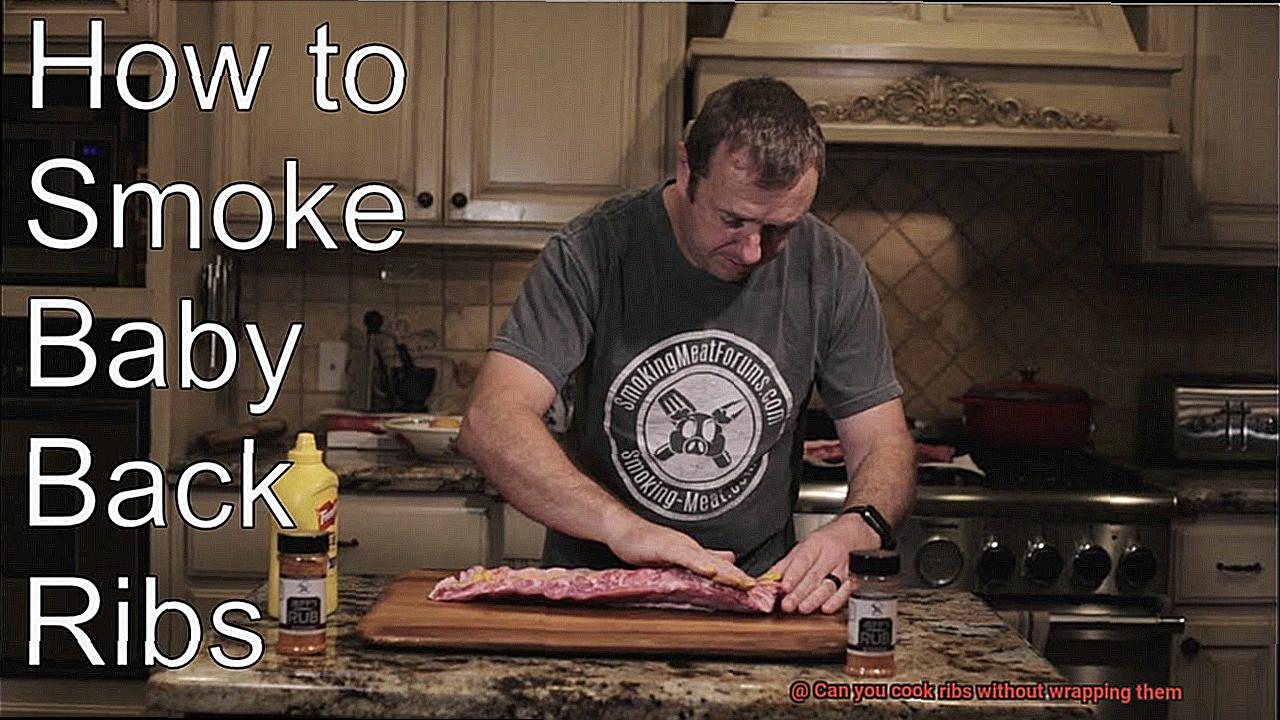
Visual cues are a great starting point. Look for that beautiful caramelized crust on the outside of your ribs, with the meat gently pulling away from the bone. This enticing color indicates that your ribs are fully cooked and ready to be devoured.
To ensure accuracy, grab your trusty meat thermometer. Insert it into the thickest part of the meat, avoiding any bones. Aim for an internal temperature of around 190°F (88°C). This temperature guarantees that your ribs are cooked through and tender.
Speaking of tenderness, a crucial factor in determining doneness, grab a toothpick or skewer. Insert it into the meat and see if it glides through easily without much resistance. If it does, congratulations. Your ribs are perfectly tender and ready to be enjoyed.
Now let’s engage our olfactory senses. When your ribs are fully cooked, they release an irresistible aroma that will make your neighbors green with envy. That mouthwatering smell is a sure sign that all the flavors have melded together harmoniously.
Remember that cooking times can vary depending on factors like rib type and thickness, as well as grill temperature. Experimentation may be required to find your sweet spot, but trust me, it will be well worth the effort.
Spritzing with Liquid Mixture: Maintaining Moisture
This game-changing method will not only maintain moisture but also enhance the flavor of your ribs, without the hassle of wrapping.
Spritzing involves periodically spraying your ribs with a delicious liquid mixture during the cooking process. It’s like a refreshing rain shower for your meat, keeping it succulent and preventing it from drying out. But that’s not all – this technique adds a burst of flavor that will make your taste buds dance with joy.
The magic behind spritzing lies in its ability to replenish the natural juices released by the ribs as they cook. By periodically spritzing, you ensure that the meat stays moist and tender throughout the cooking time. Additionally, it helps break down tough connective tissues, resulting in that coveted fall-off-the-bone goodness.
To get started, arm yourself with a spray bottle filled with your liquid mixture of choice. Popular options include apple juice, vinegar, and spices. These ingredients not only add moisture but also infuse your ribs with mouthwatering flavors. Don’t forget to set your spray bottle to a fine mist setting for even distribution over every glorious inch of those ribs.
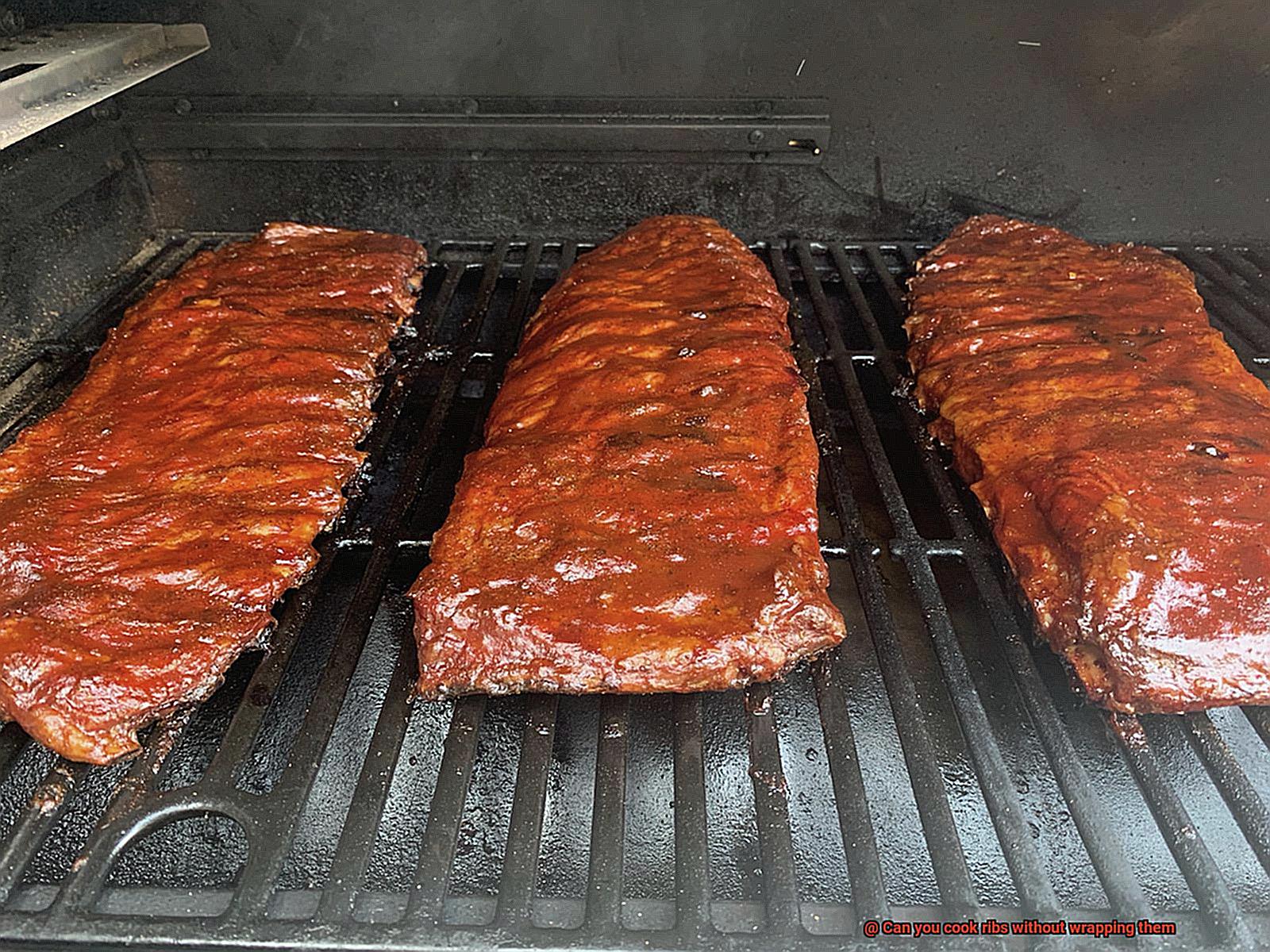
But don’t stop at the basics – let your creativity flow when crafting your liquid mixture. Add a tangy sweetness by incorporating different fruit juices like orange or pineapple. If you’re feeling adventurous, Worcestershire sauce or soy sauce can provide an umami boost that will leave your guests begging for more. The possibilities are endless.
Now here’s the secret: moderation is key when spritzing. Too much liquid can turn your ribs soggy or wash away any dry rub or seasoning you’ve lovingly applied. A light misting every 30 minutes or so should do the trick, but adjust based on your cooking temperature and desired level of moisture.
Pros and Cons of Unwrapped Ribs
When it comes to taking your grilling game to the next level, unwrapped ribs might just be the ticket to barbecue bliss. While this method may not be for everyone, it offers a range of pros and cons that are worth exploring.
Let’s start with the pros. The first advantage of cooking unwrapped ribs is the enhanced flavor. By exposing the ribs directly to the smoke and heat, they have the opportunity to develop a more robust and concentrated flavor. Imagine sinking your teeth into a tender piece of meat that bursts with smoky goodness – that’s what unwrapped ribs can offer.
Next up, we have the crispy bark. Wrapping ribs in foil or butcher paper can create a tender texture, but it often sacrifices the crispy bark that many barbecue enthusiasts crave. Cooking ribs unwrapped allows that outer layer to develop a delightful crunch, adding an enjoyable contrast to the tender meat inside.
And let’s not forget about time. One advantage of cooking unwrapped ribs is that it generally requires less time compared to the wrapped method. Without the added step of wrapping and unwrapping, you can save valuable cooking time, making this method ideal for those who want their ribs ready sooner.
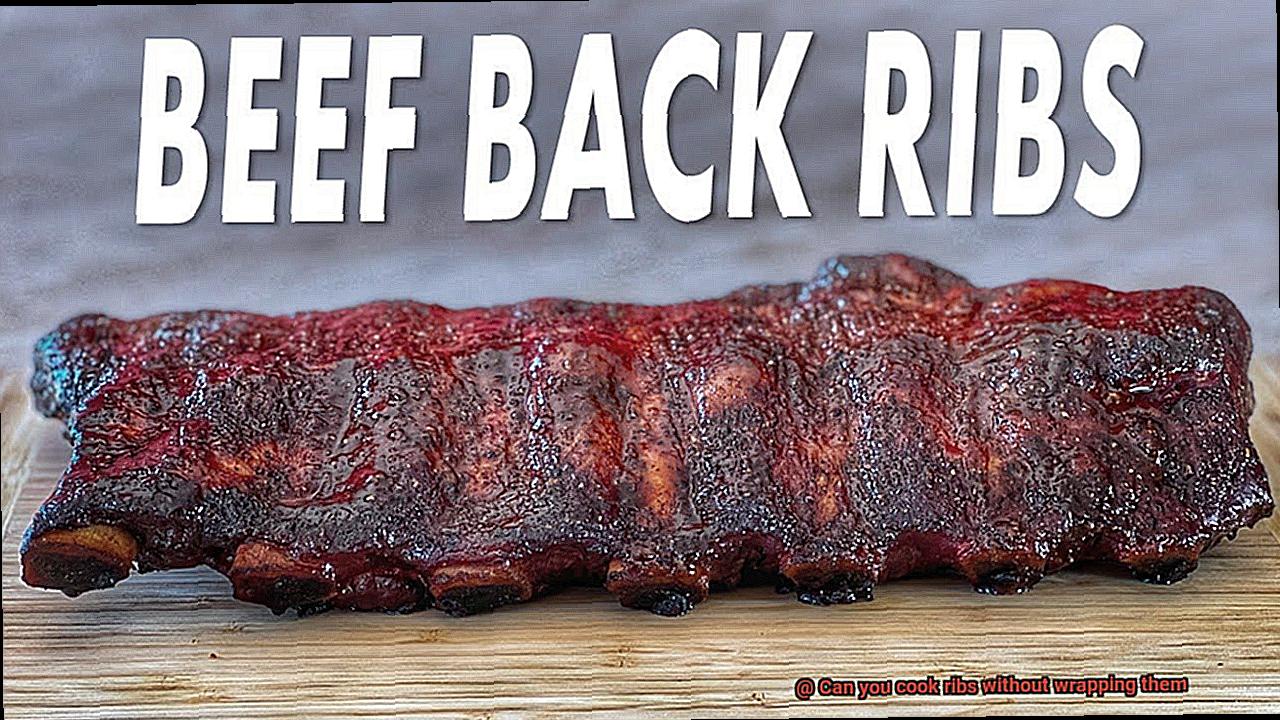
Now, let’s dive into the cons. The first drawback of cooking unwrapped ribs is the potential dryness. Without any protective barrier, the heat source can cause the moisture in the meat to evaporate more quickly, leading to dryer ribs if not properly monitored. So be sure to keep a close eye on your ribs and adjust cooking times accordingly to avoid any dry disappointments.
Another con is the limited tenderness. While unwrapped ribs can develop a crispy exterior, they may not achieve the same level of tenderness as their wrapped counterparts. Wrapping helps retain moisture and creates a more gentle cooking environment, allowing the connective tissues in the meat to break down more effectively, resulting in more tender ribs.
Lastly, unwrapped ribs are more susceptible to smoke fluctuations. Without any wrapping, they are directly exposed to the smoke, which can lead to uneven smoke flavor throughout the meat or even excessive smokiness if not carefully managed. So be mindful of your smoke levels and adjust accordingly to achieve that perfect balance of smoky goodness.
-LqRW900TuQ” >
Conclusion
In conclusion, the answer to the question “Can you cook ribs without wrapping them?”
is a resounding yes. Wrapping ribs in foil or butcher paper has become a popular technique for achieving tender and juicy results.
However, it is not the only way to cook delicious ribs. By opting to skip the wrapping step, you can create a unique and flavorful experience.
Without the confinement of foil or paper, the ribs are allowed to develop a beautiful crust on the outside while remaining moist and succulent on the inside. The key lies in careful temperature control and basting with your favorite marinade or sauce.
So, go ahead, break free from tradition and explore new horizons in rib cooking.

